ORIF - Dorsoradial double plate
1. Preliminary Remarks
These are complete articular fractures with both simple articular and metaphyseal components. They may involve a dorsomedial articular fragment, or a sagittal or frontal articular fracture line.
As these are intraarticular fractures, they should be treated with anatomic reduction and absolute stability to minimize the risk of subsequent degenerative changes in the joint.
Anatomical reduction and stabilization of these fractures are also essential because of the functional implications of the involvement of the distal radioulnar joint.
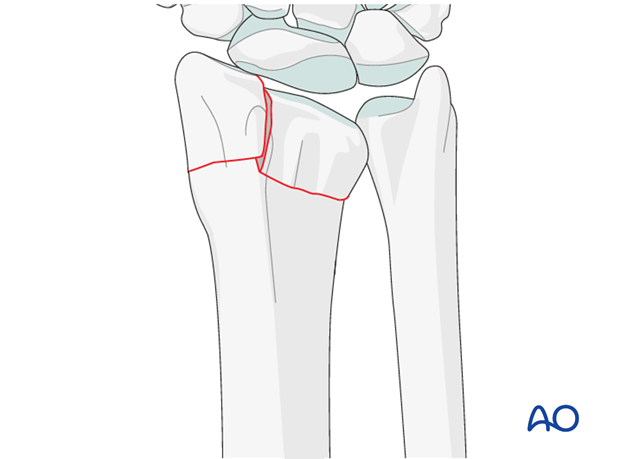
Provisional reduction in displaced fractures
Reduction is achieved by applying longitudinal traction either manually or using Chinese finger traps.
The reduction is maintained by a temporary splint.
If definitive surgery is planned, but cannot be performed within a reasonable time scale, a temporary external fixator may be helpful.
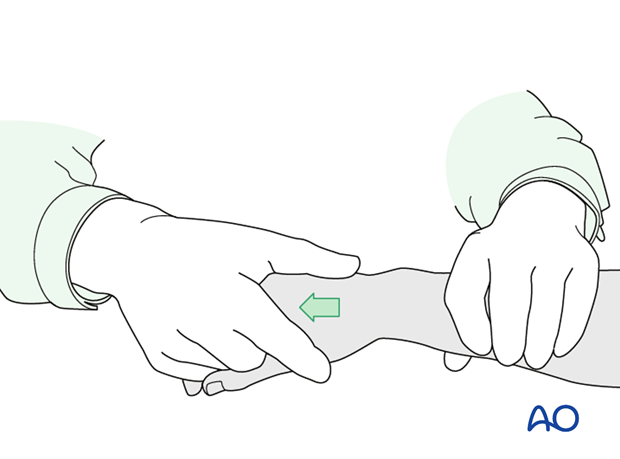
2. Associated injuries
Median nerve compression
If there is dense sensory loss, or other signs of median nerve compression, the median nerve should be decompressed.
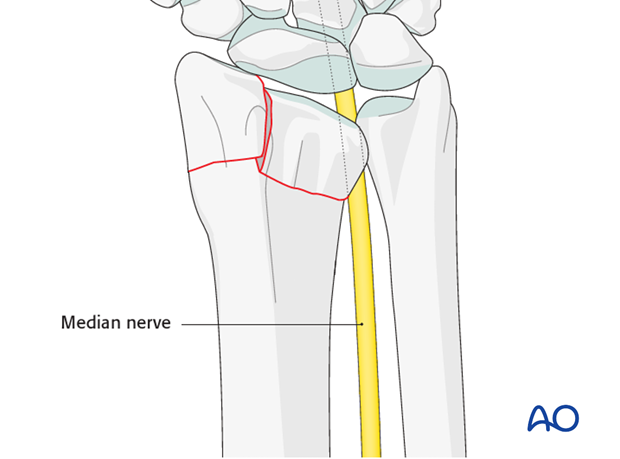
Associated carpal injuries
These injuries may be associated with shearing injuries of the articular cartilage, scaphoid fracture and rupture of the scapholunate ligament (SL). Every patient should be assessed for this injury. If present, see carpal bones of the Hand module.
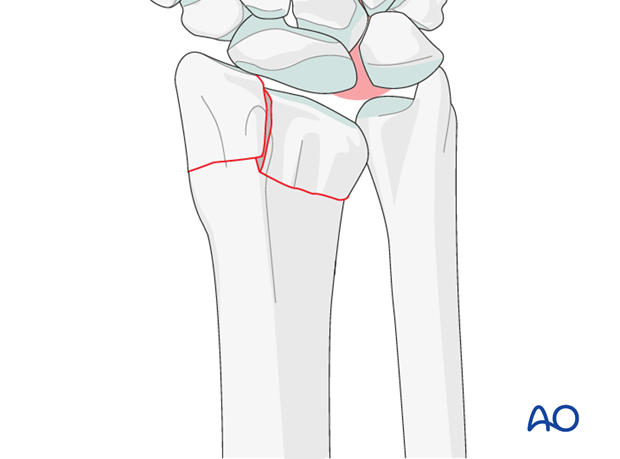
DRUJ/ulnar injuries
These injuries may be accompanied by avulsion of the ulnar styloid and/or disruption of the DRUJ. If there is gross instability after the fixation of the radial fracture, it is recommended that the styloid and/or the triangular fibrocartilaginous disc (TFC) is reattached. This is not common in simple fractures, but may occur with some high energy injuries.
The uninjured side should be tested as a reference for the injured side.
It may not be possible to assess DRUJ stability until the fracture has been stabilized (as described below).

3. Principles
Buttressing the intermediate and radial columns
In dorsal double plating, the intermediate column and the radial column are buttressed, each with a separate plate. The radial column is buttressed by a plate placed radially, deep to the first extensor compartment. The intermediate column is buttressed with a separate, precontoured plate on the dorsal aspect of the intermediate column.
A buttress plate resists axial load by applying a force at 70°-90° to the axis of potential displacement. In meta-/epiphyseal shear, or split, fractures, fixation with lag screws alone is not sufficient. A plate with buttress function will protect a lag screw from shear forces in the fracture plane. Plates can be used to provide buttress with or without lag screws.
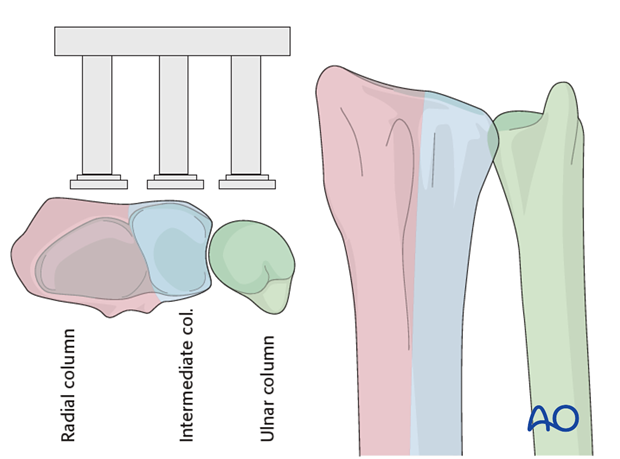
4. Patient preparation and approach
Patient preparation
This procedure is normally performed with the patient in a supine position for dorsal approaches.

Approach
For this procedure a dorsal approach is normally used.
A thorough knowledge of the anatomy around the wrist is essential. Read more about the anatomy of the distal forearm.
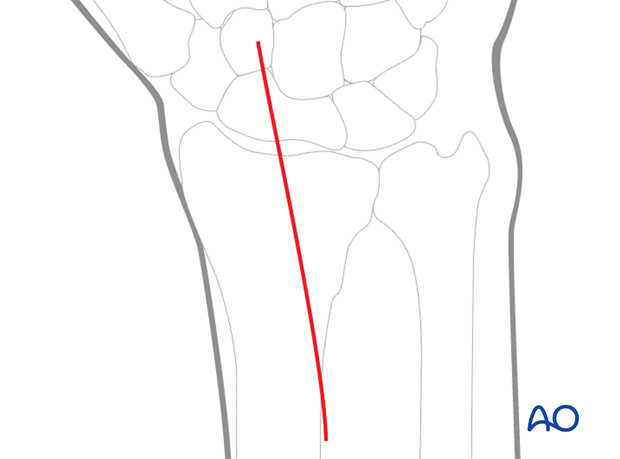
5. Radial column
Plate selection
Dedicated radial column plates are available precontoured. However, some additional contouring may be necessary to accommodate the individual anatomy of some patients.
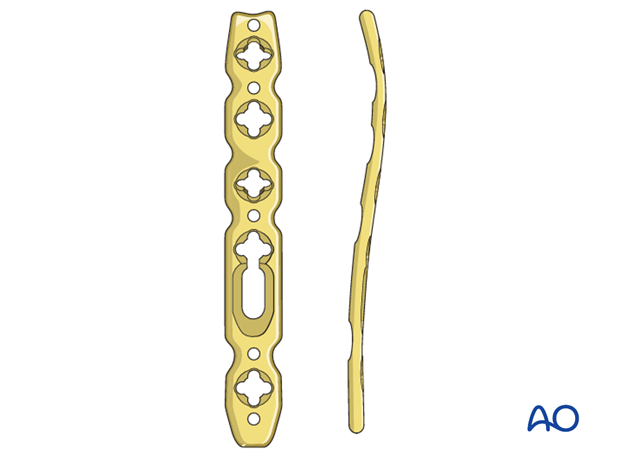
Pitfall: Screw hole distortion
Avoid contouring the plate through the locking holes, otherwise the locking head screw might not fit any more.

Variable angle locking plates enable precise positioning of the distal screws in desired directions, because there is 30° of freedom for each screw inside the plate hole to address the individual fracture patterns.
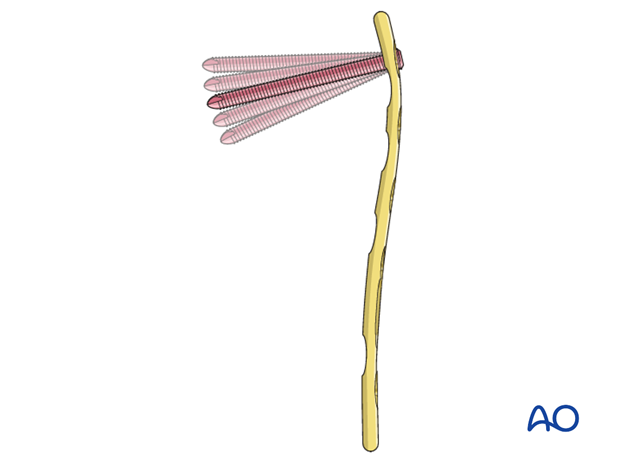
Application of the plate
Slide the plate underneath the first compartment and apply it onto the radial column.
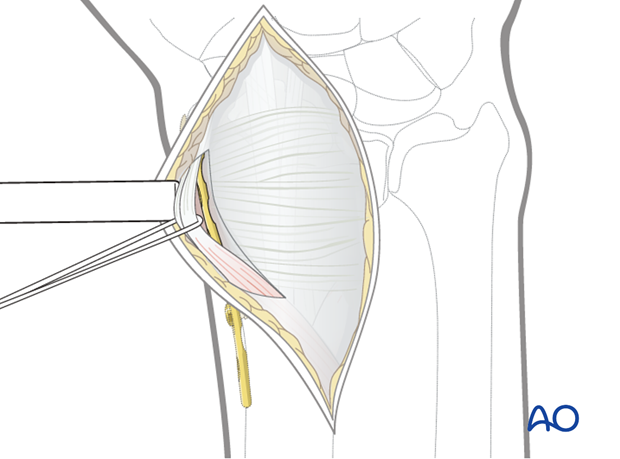
Buttressing the radial column
It may be helpful to reduce and provisionally fix the radial styloid fragment with a K-wire. Slip the S-shaped plate underneath the 1st compartment. The plate may be positioned against the K-wire to buttress the radial column.

Pitfall: Inadequate buttressing
To create a buttress for the radial styloid, the plate must be positioned correctly on the radial styloid, on its true lateral aspect.
Note
Placement of the plate on the dorsal aspect of the radial column is to be avoided as it will not buttress the reduction adequately against axial shear forces

Insert a standard cortical screw into the oblong hole proximal to the fracture (in the buttress position of the plate). The position of the plate may be adjusted before the screw is tightened.
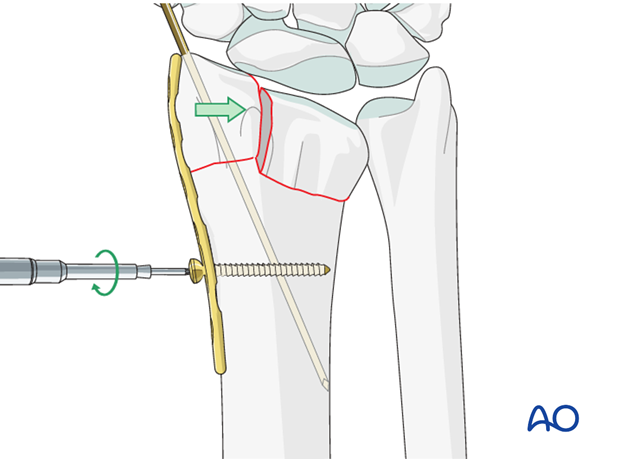
Tightening this screw will reduce the radial styloid.
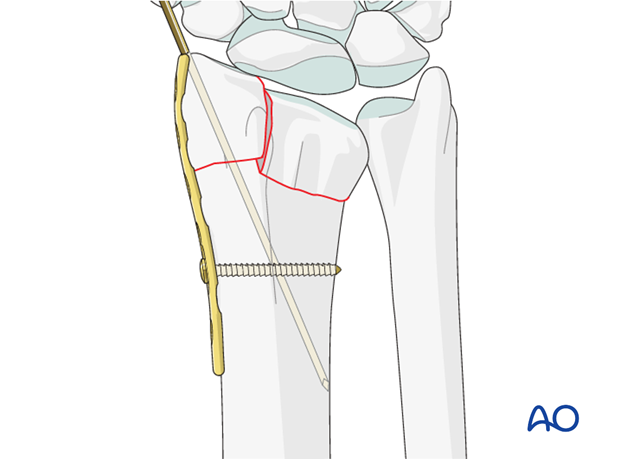
6. Intermediate column
Arthrotomy
If direct vision of the articular surface is needed, a limited, transverse, radiocarpal arthrotomy is performed.
The joint surface is now visible. Check the proximal carpal row for additional ligament injury.
The radial insertion of the triangular fibrocartilage complex can also be checked.

Reduction of ulnar articular fragment
The intermediate column must now be restored. The ulnar fragment may be found impacted into the metaphysis. This must be levered up to the level of the joint. Anatomically reduce the entire radiocarpal joint under direct vision.
Preliminary fixation with K-wires is an option.
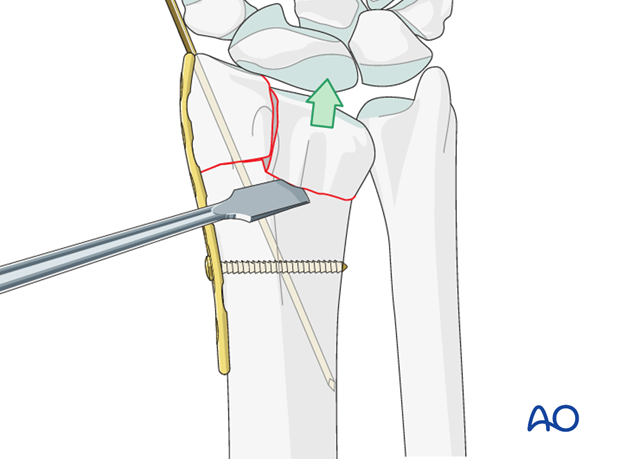
Plate selection and preparation
The appropriate plate is selected according to the fracture configuration. The plate should fit exactly the anatomy of the intermediate column. If necessary, the plate can be contoured.
A plate which allows variable angle locking screws may be very useful in this situation.
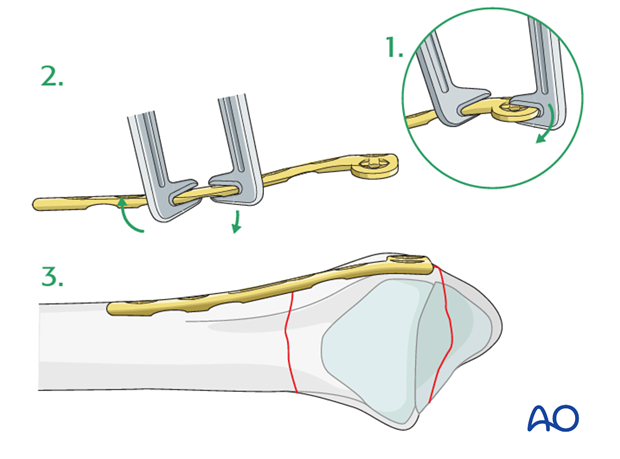
Pitfall: Screw hole distortion
Avoid contouring the plate through the locking holes, otherwise the locking head screw might not fit any more.

Plate application
The plate is positioned so that it buttresses the intermediate column and supports the reconstructed radiocarpal joint surface.
Fix the plate provisionally to the bone with a standard cortex screw inserted through the oblong plate hole. Check the reduction and plate position using image intensification.
Before fully tightening it, check the plate position using intraoperative imaging, adjusting the position of the plate as necessary.
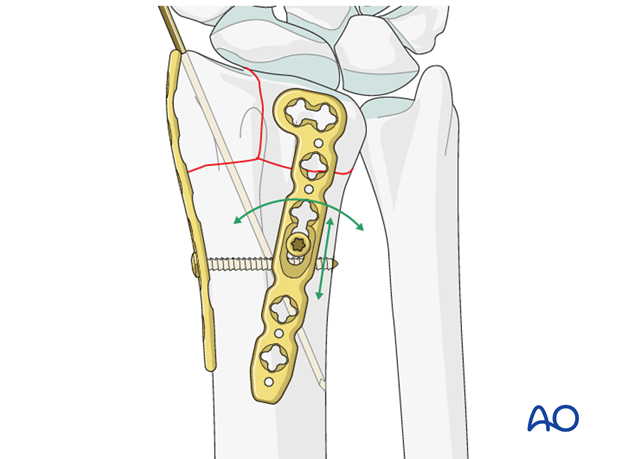
7. Complete the fixation
First, insert the most proximal screw through the intermediate column plate.
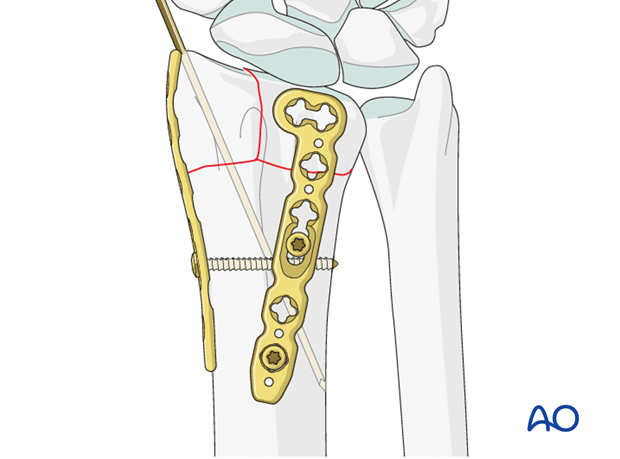
Then locking head screws are inserted into the distal, transverse limb of the intermediate column plate to support the radiocarpal joint surface.
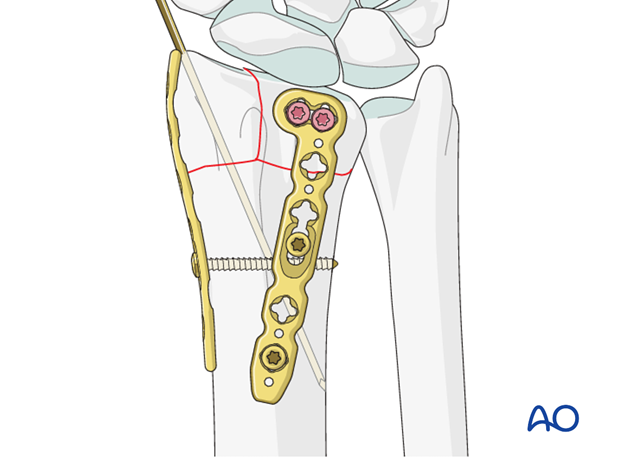
The position of the distal screws is verified by imaging. If the screws appear to enter the radial carpal joint, they can be repositioned if a variable angle locking plate has been used.
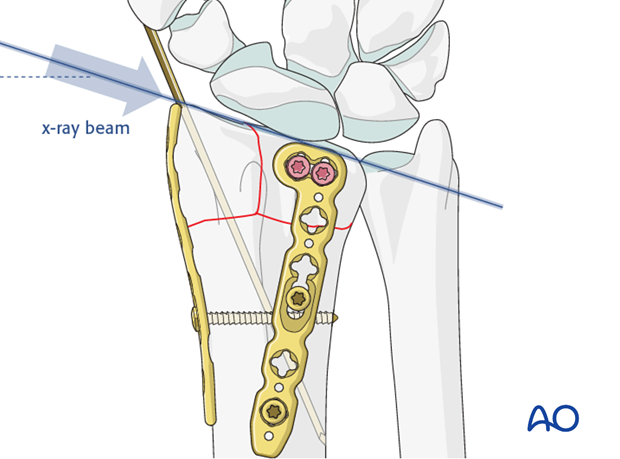
Complete the fixation of the radial column in a similar manner. First, insert the most proximal screw.

Finally, if a K-wire was used, it is now removed and distal locking head screw(s) inserted to support the radial styloid.
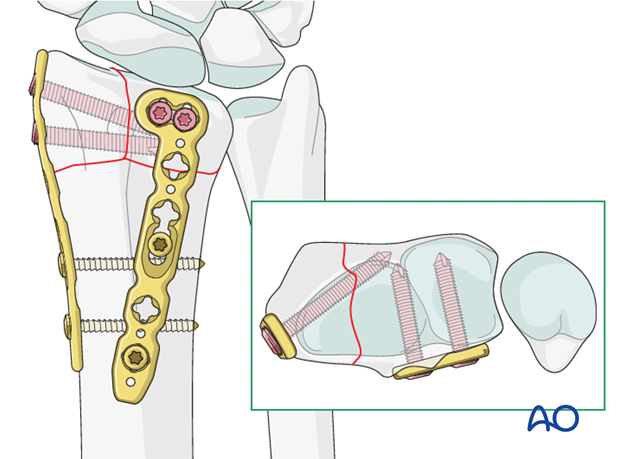
The plates should now form an angle of 70º-90º to each other.
Check the reduction and correct screw position using image intensification.

8. Assessment of Distal Radioulnar Joint (DRUJ)
Before starting the operation, the uninjured side should be tested as a reference for the injured side.
After fixation, the distal radioulnar joint should be assessed for forearm rotation, as well as for stability. The forearm should be rotated completely to make certain there is no anatomical block.
Method 1
The elbow is flexed 90° on the arm table and displacement in dorsal palmar direction is tested in a neutral rotation of the forearm with the wrist in neutral position.
This is repeated with the wrist in radial deviation, which stabilizes the DRUJ, if the ulnar collateral complex (TFCC) is not disrupted.
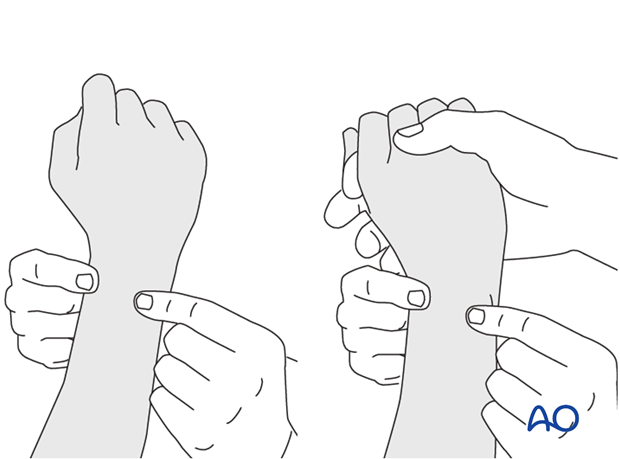
This is repeated with the wrist in full supination and full pronation.
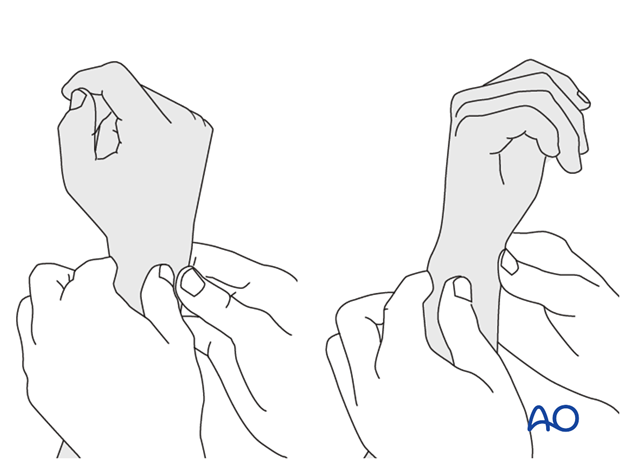
Method 2
To test the stability of the distal radioulnar joint, the ulna is compressed against the radius...

...while the forearm is passively put through full supination...

...and pronation.
If there is a palpable “clunk”, then instability of the distal radioulnar joint should be considered. This would be an indication for internal fixation of an ulnar styloid fracture at its base. If the fracture is at the tip of the ulnar styloid consider TFCC stabilization.
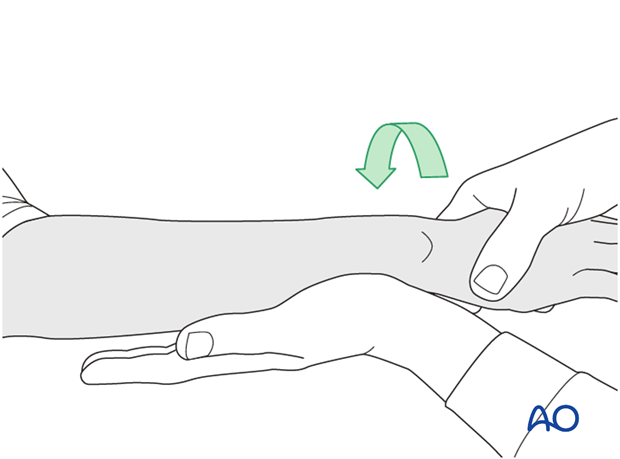
9. Aftercare
Functional exercises
Immediately postoperatively, the patient should be encouraged to elevate the limb and mobilize the digits, elbow and shoulder.
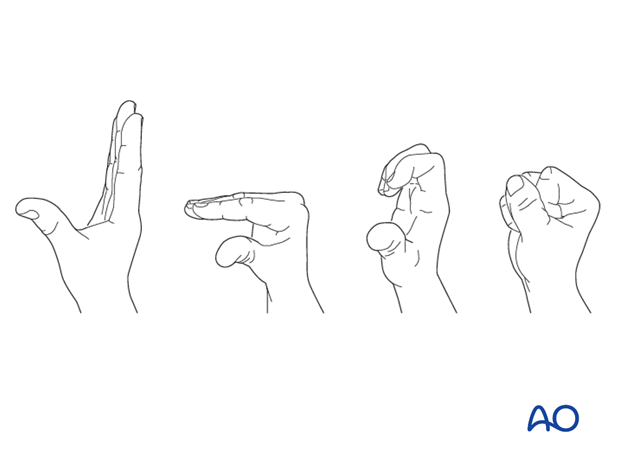
Some surgeons may prefer to immobilize the wrist for 7-10 days before starting active wrist and forearm motion. In those patients, the wrist will remain in the dressing applied at the time of surgery.

Wrist and forearm motion can be initiated when the patient is comfortable and there is no need for immobilization of the wrist after suture removal.
Resisted exercises can be started about 6 weeks after surgery depending on the radiographic appearance.
If necessary, functional exercises can be under the supervision of a hand therapist.

Follow up
See patient 7-10 days after surgery for a wound check and suture removal. X-rays are taken to check the reduction.
Implant removal
Implant removal is purely elective but may be needed in cases of soft-tissue irritation, especially tendon irritation to prevent late rupture. This is particularly a problem with dorsal or radial plates. These plates should be removed between nine and twelve months.













